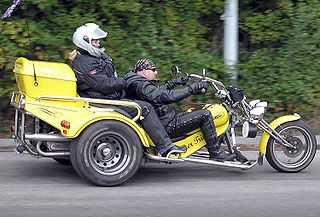
An anti-lock braking system (ABS) is a safety anti-skid braking system used on aircraft and on land vehicles, such as cars, motorcycles, trucks and buses. ABS operates by preventing the wheels from locking up during braking, thereby maintaining tractive contact with the road surface.

The MacPherson strut is a type of automotive suspension system that uses the top of a telescopic damper as the upper steering pivot. It is widely used in the front suspension of modern vehicles and is named for American automotive engineer Earle S. MacPherson, who invented and developed the design.

Four-wheel drive, also called 4×4 or 4WD, refers to a two-axled vehicle drivetrain capable of providing torque to all of its wheels simultaneously. It may be full-time or on-demand, and is typically linked via a transfer case providing an additional output drive-shaft and, in many instances, additional gear ranges.

Front-wheel drive (FWD) is a form of engine and transmission layout used in motor vehicles, where the engine drives the front wheels only. Most modern front-wheel-drive vehicles feature a transverse engine, rather than the conventional longitudinal engine arrangement generally found in rear-wheel-drive and four-wheel drive vehicles.

In automotive design, an FF, or front-engine, front-wheel-drive (FWD) layout places both the internal combustion engine and driven roadwheels at the front of the vehicle.

In automotive design, a RMR or Rear Mid-engine, rear-wheel-drive layout is one in which the rear wheels are driven by an engine placed just in front of them, behind the passenger compartment. In contrast to the rear-engined RR layout, the center of mass of the engine is in front of the rear axle. This layout is typically chosen for its low moment of inertia and relatively favorable weight distribution. The layout has a tendency toward being heavier in the rear than the front, which allows for best balance to be achieved under braking. However, since there is little weight over the front wheels, under acceleration, the front of the car is prone to lift and cause understeer. Most rear-engine layouts have historically been used in smaller vehicles, because the weight of the engine at the rear has an adverse effect on a larger car's handling, making it 'tail-heavy'. It is felt that the low polar inertia is crucial in selection of this layout. The mid-engined layout also uses up central space, making it impractical for any but two-seater sports cars. However, some microvans use this layout, with a small, low engine beneath the loading area. This makes it possible to move the driver right to the front of the vehicle, thus increasing the loading area at the expense of slightly reduced load depth.

In automotive design, an FR, or front-engine, rear-wheel-drive layout is one where the engine is located at the front of the vehicle and driven wheels are located at the rear. This was the traditional automobile layout for most of the 20th century. Modern designs commonly use the front-engine, front-wheel-drive layout (FF).

Full-size car— also known as large car is a vehicle size class which originated in the United States and is used for cars larger than mid-size cars. It is the largest size class for cars. The equivalent European categories are E-segment and executive car.

Singer Motors Limited was a British motor vehicle manufacturing business, originally a bicycle manufacturer founded as Singer & Co by George Singer, in 1874 in Coventry, England. Singer & Co's bicycle manufacture continued. From 1901 George Singer's Singer Motor Co made cars and commercial vehicles.

David was a Spanish company manufacturing cars in Barcelona between 1913 and 1923 and again between 1951 and 1957.
Goliath-Werke Borgward & Co. was a German car manufacturer started by Carl F. W. Borgward and Wilhelm Tecklenborg in 1928, and was part of the Borgward group. Goliath was based in Bremen and specialized in three-wheeler cars and trucks and medium-sized cars. Their vehicles were sold under the Goliath brand.

Brennabor-Werke AG was a German manufacturer of infant buggies, bicycles, motorcycles and, for two decades, of powered motor vehicles. It was based in Brandenburg an der Havel and operated between 1871 and 1945.

Coventry Premier Limited owned a British car and cyclecar manufacturing business based in Coventry from 1912 to 1923. It changed its name from Premier Cycles to Coventry Premier Ltd in November 1914.
The layout of a car is often defined by the location of the engine and drive wheels.
Edward Butler (1862–1940) was an English inventor who produced an early three-wheeled petrol automobile called the Butler Petrol Cycle, which is accepted by many as the first British car.

Cyklon was a German make of car produced from 1902 to 1931. It was primarily noted for its unique three-wheeled design.

The Renault KJ was a compact car or small family car automobile manufactured by Renault from 1923 to 1924.

A motorized tricycle, motor trike, or three-wheeled motorcycle is a three-wheeled vehicle based on the same technology as a bicycle or motorcycle, and powered by an electric motor, motorcycle, scooter or car engine. These are mainly used by old motorcyclists that can not reverse using their feet

Derby is a former vintage era automobile maker based in Courbevoie, Seine, France.
















